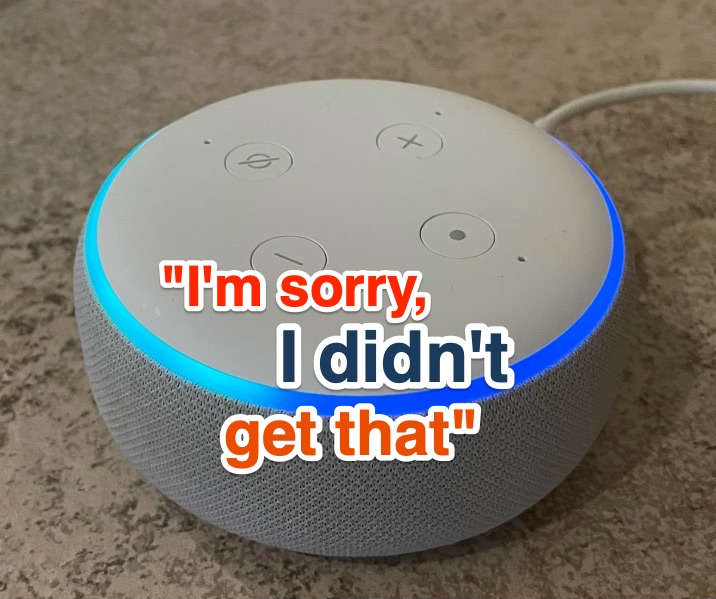More than one in twenty people—an estimated 430 million people—experience disabling hearing loss according to the World Health Organization’s 2021 fact sheet on deafness and hearing loss. Some are functionally deaf, having little to no hearing. Others are culturally Deaf with a preference for communicating with sign language. A lack of public awareness and familiarity with d/Deaf people’s needs is still common, which can lead to oversights in the designs of smart devices, web content, mobile apps and communication styles. Let’s look at five ways that we can improve online experiences for d/Deaf users.
1. Include visual indicators of audio cues
If your presentation or device relies on sound alone, that isolates and potentially endangers functionally deaf users. Provide visual indicators in addition to audio cues to lessen any confusion for people who can’t hear errors or successes in a process. You also need to provide a visual indicator for each audio cue in the context of what triggered it. If you don’t, users might not know what the visual indicator refers to.
The Internet of things
Smart devices like talking speakers promise to make our lives easier, but their very nature excludes d/Deaf users who can’t hear those devices or communicate in ways that those devices understand. A talking speaker without a visual display poses an accessibility barrier. Some device makers offer add-on products that have screens, captioning, and access to common actions, but those don’t offer equivalent experiences yet. Researchers have identified several gaps in home automation for d/Deaf users [PDF] with appliances that rely on sounds.

2. Provide text equivalents of audio content
Any communication that contains sound, such as streaming video and audio materials, needs to include visual equivalents. That includes transcripts for podcasts and accurate subtitles for all videos. Beyond word-for-word captioning, you should also indicate who’s speaking as well as any important sounds, like a doorbell ringing or a window breaking. Tag your accessible videos with #captioned.
Video conferencing
The pandemic thrust us into endless video calls, a communication style that d/Deaf people can find challenging when there are many speakers. Enabling auto-captioning can make these conversations more accessible than they would be otherwise. Meryl Evans, who uses lipreading in combination with captions, recommends considering these features when selecting an auto-captioning tool:
- Readability of captions: formatting size, color and scrolling
- Caption placement
- Accuracy of captions
- Synchronization options
- Caption flow and movement
- Support for saving transcripts

Automatic captions are not perfect—do not rely on them when posting pre-recorded video—but they are a useful accessibility tool for video calls. If possible, clean up captions before posting webinar and conference recordings.
3. Provide sign language
Providing sign language interpretation and captions for content can help deaf sign language users—especially for online webinars and conferences. More and more people are consuming video content in sign languages and more people are creating their own signing videos to communicate online. Keep in mind that sign languages vary across the globe; know your audience and adapt which sign language is used in your videos.

Video chat
Providing video options in chat apps is crucial for including deaf sign-language users. A Deaf American Sign Language instructor I had emphasized how video-phone technology on devices like smartphones has dramatically improved sign language users’ ability to communicate easily with each other, compared to using relay services and text-telephone devices.
4. Write with d/Deaf people in mind
If you’re interested in creating better written content for d/Deaf users, read “Deafness and the User Experience” by Lisa Herrod. Her guidelines when writing for the web include:
- Use headings and subheadings
- Use plain language whenever possible
- Avoid unnecessary jargon and slang
- Provide a glossary of specialized vocabulary
- Write clearly and concisely to help readers avoid misinterpreting what you’ve written, which will help all people readers, not just those with disabilities
5. Test designs with d/Deaf people
There’s a saying in the disability rights movement: “Nothing about us without us”. In essence we cannot build systems for people with specific needs without involving them in the process. We might know all the right success criteria to meet, have confidence in our transcripts and captions, yet we are not our representative users. It’s essential to get feedback from d/Deaf people during usability testing of wireframes and prototypes, before going live with designs that might be excluding them.
Conclusion
Understanding d/Deaf users’ needs is crucial for creating systems that allow fair and equal access. When designers and developers consider these needs, it helps teams build systems that go beyond a reliance on sound to include d/Deaf people.